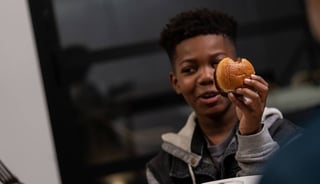From Catering to Guest Segments: Inside the Tech Strategies of Leading Restaurants

This article outlines:
How leading restaurant brands are aligning technology with their core mission
The strategic use of guest data to personalize marketing
Why simplicity and stability in digital platforms are critical for operational excellence
When it comes to restaurant technology, there’s a huge difference between offering online ordering and creating a personalized, easy-to-use guest experience.
Brands that make smart use of technology offer frictionless ordering and use guest data to create loyal repeat guests—and a difference in their bottom line. At Olo’s Beyond4 customer event, five restaurant IT leaders for major brands shared their best practices when it comes to restaurant technology. Read on to learn how Bojangles streamlined catering, how FAT Brands creates smart customer segments, and more.
Thinking cross-functionally about tech decisions
Brian Pearson, CTO of Mendocino Farms, emphasized the purpose of technology is to help each department at the brand accomplish its goals. Rather than pursuing slick software or cool gadgets for their own sake, his team focuses on how tech tools can enhance marketing communications, provide guest insights, and improve systems.
"Our job as technologists is to support what everybody else generally does. We support our marketing teams in making sure they can communicate effectively with our guests. We have to be thinking all the time about how we are helping the brand be more of what the brand needs to be instead of just thinking about this tool set that I'm interested in or the whiz-bang thing that's coming next."
Pearson's approach centers on using technology to create better experiences for team members and guests while advancing the brand's core mission.
On the menu: personalized connections
Susan Taylor, President and CEO of Juice It Up!, highlighted the power of data-driven guest insights. The brand’s loyalty program provides detailed information about guest preferences, visit patterns, and spending habits.
"We have insights on all of our loyalty guests. I know how often they come, which stores they go to, and the time of day that they come. If you often order acai and I'm launching a new acai product, I can send you an offer. You're probably more likely to come in to try that, as opposed to me just sending it out to everybody or someone that only comes in for a raw juice."
Taylor's approach demonstrates how leveraging specific guest menu preferences and likes can transform generic marketing into personalized experiences that encourage repeat visits and ultimately drive more sales.
Uncovering guest behavior patterns
Looking beyond a loyalty program’s reach to all guests has become essential for Lisa Cheatham, VP of Marketing and Revenue Channels at FAT Brands. She recognizes a complete view of guest behavior requires analyzing both loyalty and non-loyalty program guests.
“The ultimate goal with data is to be able to get to a single source of truth for a guest. I want to see not just a guest who’s in a loyalty program. Maybe there's a whole host of guests who are not in our loyalty program and are coming to our stores, and I want to see what their purchasing habits are. If they're purchasing from us in different channels, I ultimately want to be able to say, here are different segments of guests within the loyalty program, outside of the loyalty program, and what we can do to attract those that look like them, and then also identify their trends and habits, no matter what channel they're using.”
By unifying guest purchasing preferences and insights across all touchpoints, brands can create more effective and personalized marketing, ultimately forming more meaningful connections with guests.
Online ordering should be easy
Eric Stepp, Senior Off-Premise and Catering Manager at Bojangles, has found the brand’s guests are looking for ease and efficiency—especially when it comes to catering. Stepp focuses on streamlining the ordering process so catering guests can quickly select the right amount of food without having to navigate lengthy, complex menus.
"For guests, the biggest thing is ease. And so, for us, we want to make sure a guest knows how much food they need to get, and they can order it quickly. You don't want to have a menu that takes them 30 minutes to look through and scroll."
Using technology streamlines operations and ensures timely, accurate order fulfillment, creating a seamless experience for both guests and staff.
Choosing the right ordering platform plays a huge role here: it should minimize decision fatigue and accelerate purchases for guests whether they're placing a large catering order or a single order and streamline processes to ensure timely, accurate fulfillment.
First impressions matter
Tyler Schack, VP of IT at Walk-On's, stressed the critical importance of stability and scalability in digital platforms. For emerging enterprise brands, a guest’s first online order may be their first interaction with the brand.
"When you're an emerging enterprise brand, the first time a guest places an online order with you, whether that's through a third party or your direct channels, it's likely the first time they've interacted with your brand period. So if the guest-facing menu looks [bad] and you get thrown errors at every single step of the way, they're going to leave, they're going to go somewhere else."
Schack's focus is on creating stable platforms that deliver excellent first impressions in an intensely competitive marketplace.
Conclusion
The restaurant industry is at a technological inflection point. Today's successful restaurant leaders aren't chasing technology trends for their own sake—they're strategically implementing solutions that strengthen brand identity, enhance operational capabilities, and create meaningful guest connections. As these insights demonstrate, the most forward-thinking brands are using technology not just as a tool, but as a means to deliver more authentic, personalized experiences that keep guests coming back.
For more insights on how to prioritize tech investments, check out our Buyer’s Guide to Future-Proofing Your Restaurant Tech Stack.

